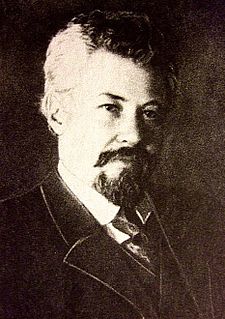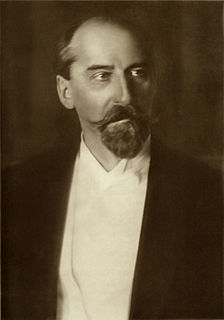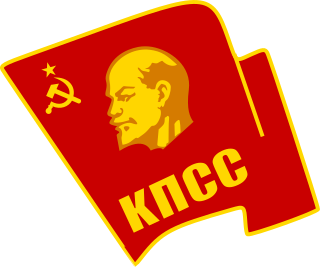 |
|---|
The Estonian Radical Democratic Party (Estonian : Eesti Radikaal-Demokraatlik Erakond, ERDE) was a political party in Estonia.
 |
|---|
The Estonian Radical Democratic Party (Estonian : Eesti Radikaal-Demokraatlik Erakond, ERDE) was a political party in Estonia.
The party had its roots in the Tallinn Radicals, who had formed in the early 1900s around Konstantin Päts and his Teataja newspaper. [1] By 1917 the group had coalesced into the Radical Democratic Party, which won four seats in the Estonian Provincial Assembly in 1917. In the Provincial Assembly the party was a member of the Democratic Bloc alongside the Estonian Democratic Party and the Rural League.
A rightwards shift in the party in 1918 resulted in Päts leaving to join the Rural League, leaving Ado Birk as the most prominent party member. [1] The Bloc contested the 1918 elections together, winning around 23% of the vote. Prior to the 1919 elections the ERDE merged with the Democratic Party to form the Estonian People's Party. [1]
Estonian Provincial Assembly was elected after the February Revolution in 1917 as the national diet of the Autonomous Governorate of Estonia in Russian Empire. On November 28, 1917, after the October Revolution the Assembly declared itself the sovereign power on Estonia and called for the elections of the Estonian Constituent Assembly. On the eve of the German occupation of Estonia in World War I the council elected the Estonian Salvation Committee and issued the Estonian Declaration of Independence on February 24, 1918.

Otto August Strandman was an Estonian politician, who served as Prime Minister (1919) and State Elder of Estonia (1929–1931). He was one of the leaders of the centre-left Estonian Labour Party, that saw its biggest support after the 1919 and 1920 elections. Strandman was a key figure in composing the radical land reform law and the 1920 Constitution. He also served as Minister of Agriculture (1918–1919), Minister of Justice, Minister of Finance (1924), Minister of Foreign Affairs and Minister of War (1919). While he was in the office of Minister of Finance, he stabilized the economy and managed to avoid hyperinflation. Strandman was also the speaker of both the Estonian Provincial Assembly (1917–1918) and Riigikogu (1921). He was a diplomat, serving as an envoy in Warsaw (1927–1929), when he made contacts with Polish politicians, and in Paris (1933–1939). During the Soviet Occupation in 1941, Strandman was ordered to show up to the NKVD headquarters. Already knowing about his fate, he committed suicide in his home in Kadrina.

The Prime Minister of Estonia is the head of government of the Republic of Estonia. The prime minister is nominated by the president after appropriate consultations with the parliamentary factions and confirmed by the parliament (Riigikogu). In case of disagreement, the Parliament can reject the president's nomination and choose their own candidate. In practice, since the prime minister must maintain the confidence of Parliament in order to remain in office, they are usually the leader of the senior partner in the governing coalition. The current prime minister is Kaja Kallas of the Reform Party. She took the office on 26 January 2021 following the resignation of Jüri Ratas.

Konstantin Päts was an Estonian statesman and the country's President in 1938–1940. Päts was one of the most influential politicians of independent Estonia, and during the two decades prior to World War II he also served five times as the country's Prime Minister.

Elections to the Russian Constituent Assembly were held on 25 November 1917, although some districts had polling on alternate days, around two months after they were originally meant to occur, having been organized as a result of events in the February Revolution. They are generally recognised to be the first free elections in Russian history.

Jaan Tõnisson was an Estonian statesman, serving as the Prime Minister of Estonia twice during 1919 to 1920, as State Elder from 1927 to 1928 and in 1933, and as Foreign Minister of Estonia from 1931 to 1932.
The Head of State of Estonia or State Elder was the official title of the Estonian head of state from 1920 to 1937. He combined some of the functions held by a president and prime minister in most other democracies.

The Communist Party of Estonia was a subdivision of the Soviet communist party which in 1920-1940 operated illegally in Estonia and, after the 1940 occupation and annexation of Estonia by the Soviet Union, was formally re-merged into the USSR's All-Union Communist Party (bolsheviks).
The Democratic Alliance, originally called Democratic Republican Alliance, was a French political party created in 1901 by followers of Léon Gambetta such as Raymond Poincaré, who would be president of the Council in the 1920s. The party was originally formed as a centre-left gathering of moderate liberals, independent Radicals who rejected the new left-leaning Radical-Socialist Party, and Opportunist Republicans, situated at the political centre and to the right of the newly formed Radical-Socialist Party. However, after World War I and the parliamentary disappearance of monarchists and Bonapartists it quickly became the main centre-right party of the Third Republic. It was part of the National Bloc right-wing coalition which won the elections after the end of the war. The ARD successively took the name "Democratic Republican Party", and then "Social and Republican Democratic Party", before becoming again the AD.
The Yugoslav Democratic Party, State Party of Serbian, Croatian and Slovene Democrats and Democratic Party, also known as the Democratic Union was the name of a series of liberal political parties that existed in succession in the State of Slovenes, Croats and Serbs and the Kingdom of Serbs, Croats and Slovenes.
The Georgian Socialist-Federalist Revolutionary Party was a Georgian nationalist party, founded in April 1904. The party's program demanded the national autonomy of Georgia, within the framework of a Russian federal state, and advocated for a democratic socialist system. Mainly based in the rural areas, the party's membership was almost entirely drawn from the peasantry and the petty gentry. The political profile of the party had an appeal amongst moderately nationalist intellectuals, schoolteachers and students. The party strived that agricultural issues not be decided by central authorities, but by autonomous national institutions. The party published the periodical Sakartvelo.
The Estonian Labour Party was a political party in Estonia. It was formed in 1919 by a merger of the Radical Socialist Party and the Social Travaillist Party, and ceased to exist in 1932, when it merged with other centrist parties to form the National Centre Party. It was a member of government coalitions between 1919 and 1925, and again from 1927 until 1931.
The Estonian Radical Socialist Party was a political party in Estonia.

The Farmers' Assemblies was a conservative political party in Estonia. Led by Konstantin Päts, it was one of the ruling parties during most of the interwar period.
The Social Travaillist Party was a political party in Estonia.
The Estonian Democratic Party was a political party in Estonia.
The Democratic Bloc was a political grouping in Estonia.

The Estonia electoral district was a constituency created for the 1917 Russian Constituent Assembly election. The electoral district covered the Autonomous Governorate of Estonia.
Nikolai Köstner (1889–1959) was an Estonian politician, economist, diplomat and academic. He was a member of the Provisional Assembly of the Autonomous Estonian Governorate (1917–19) and the Constituent Assembly of the newly established Republic of Estonia (1919–20); he also served as a minister in Jaan Raamot's Provincial Government in 1917, in the Second and Third Provisional Governments (1918–19), and in Otto Strandman's first Cabinet and Jaan Tõnisson's first Cabinet. He was also part of the Estonian delegation to the 1919 Paris Peace Conference. In later life, he worked as an academic at the University of Tartu and as an adviser to a number of national banks.